International Trade Finance and Investment Report - UWL Finance Module
VerifiedAdded on 2023/01/19
|19
|4793
|86
Report
AI Summary
This report provides an in-depth analysis of international trade finance and investment, focusing on the allocation of capital within domestic and international markets. It examines the financial market framework, including the roles of commercial banks, bond markets, and foreign exchange markets. The report assesses the UK's economy, including its banking system, monetary policy, and regulations. Furthermore, it explores the challenges faced by developing economies due to industrialization and trade policies, using the Russian economy as a case study. The report covers various aspects of financial investment and trade theory, offering insights into the contributions of international trade and the difficulties encountered by developing nations.
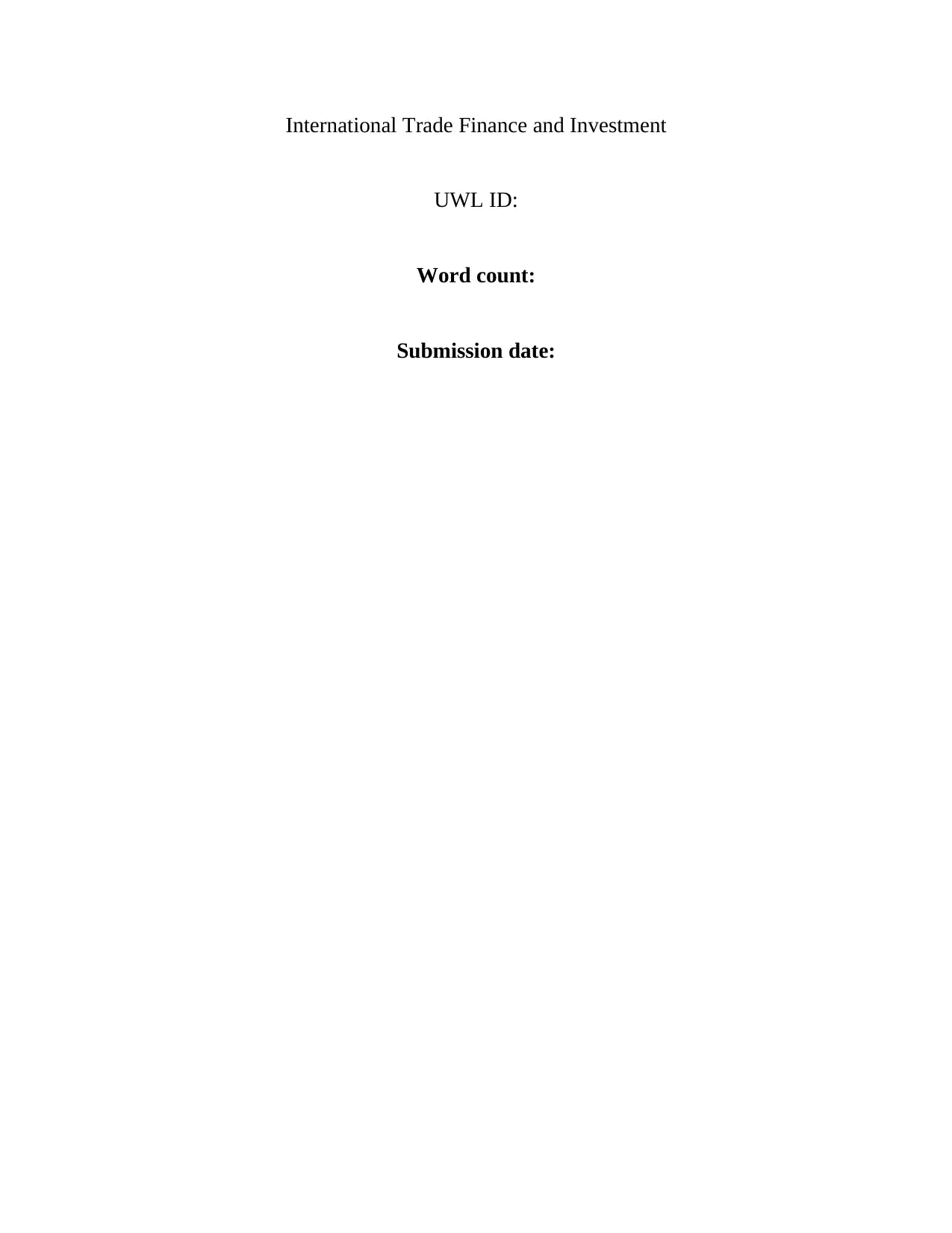
International Trade Finance and Investment
UWL ID:
Word count:
Submission date:
UWL ID:
Word count:
Submission date:
Paraphrase This Document
Need a fresh take? Get an instant paraphrase of this document with our AI Paraphraser
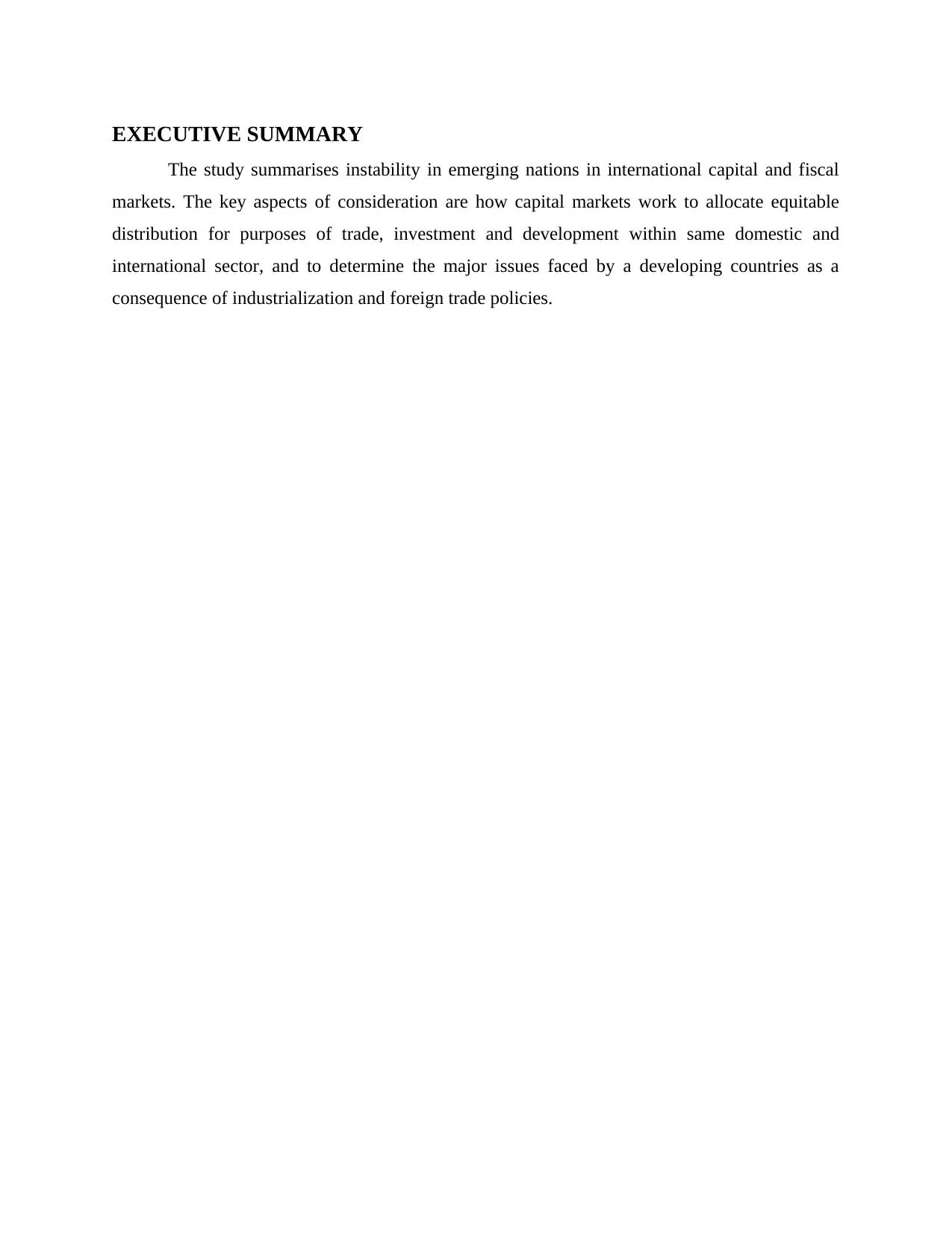
EXECUTIVE SUMMARY
The study summarises instability in emerging nations in international capital and fiscal
markets. The key aspects of consideration are how capital markets work to allocate equitable
distribution for purposes of trade, investment and development within same domestic and
international sector, and to determine the major issues faced by a developing countries as a
consequence of industrialization and foreign trade policies.
The study summarises instability in emerging nations in international capital and fiscal
markets. The key aspects of consideration are how capital markets work to allocate equitable
distribution for purposes of trade, investment and development within same domestic and
international sector, and to determine the major issues faced by a developing countries as a
consequence of industrialization and foreign trade policies.
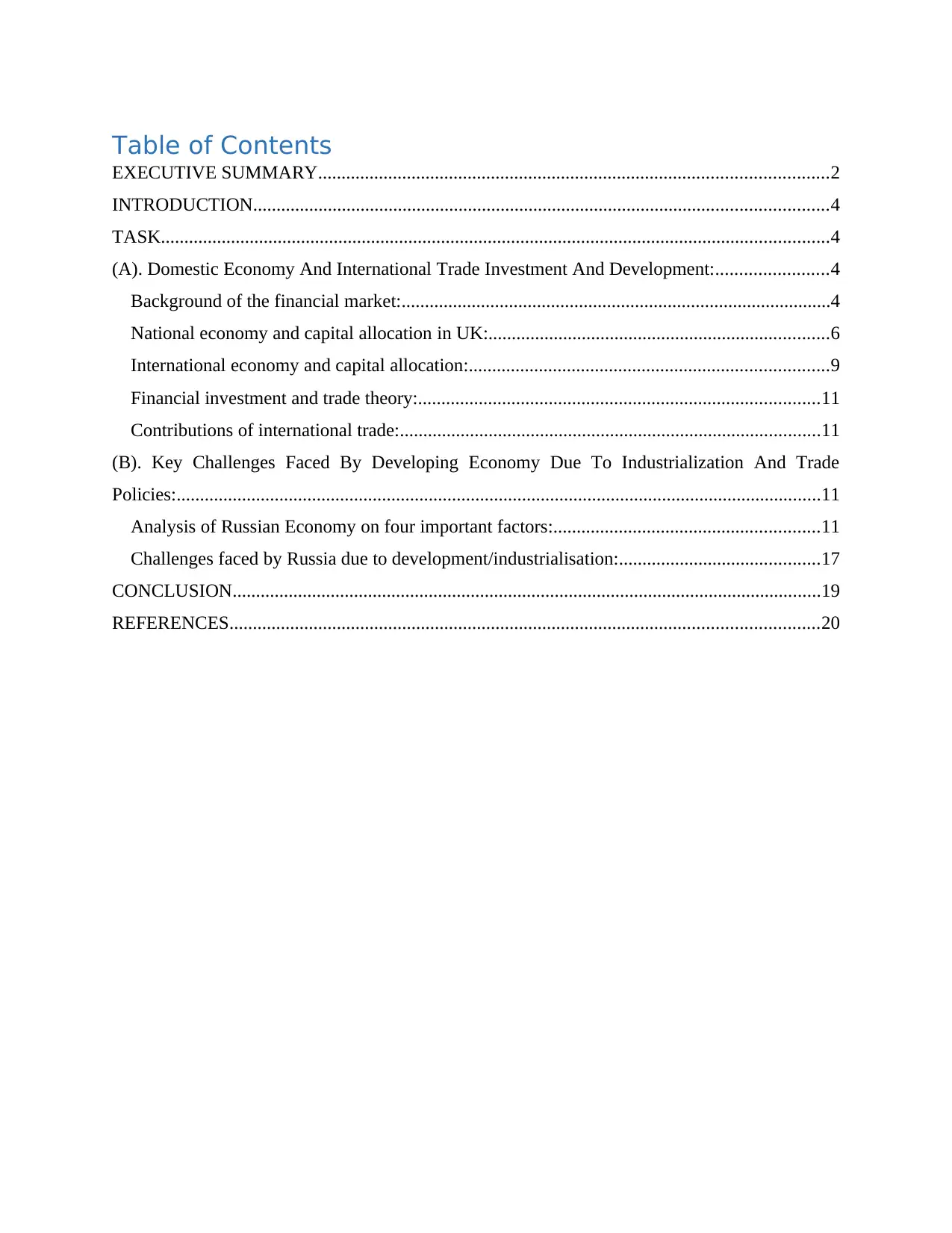
Table of Contents
EXECUTIVE SUMMARY.............................................................................................................2
INTRODUCTION...........................................................................................................................4
TASK...............................................................................................................................................4
(A). Domestic Economy And International Trade Investment And Development:........................4
Background of the financial market:............................................................................................4
National economy and capital allocation in UK:.........................................................................6
International economy and capital allocation:.............................................................................9
Financial investment and trade theory:......................................................................................11
Contributions of international trade:..........................................................................................11
(B). Key Challenges Faced By Developing Economy Due To Industrialization And Trade
Policies:..........................................................................................................................................11
Analysis of Russian Economy on four important factors:.........................................................11
Challenges faced by Russia due to development/industrialisation:...........................................17
CONCLUSION..............................................................................................................................19
REFERENCES..............................................................................................................................20
EXECUTIVE SUMMARY.............................................................................................................2
INTRODUCTION...........................................................................................................................4
TASK...............................................................................................................................................4
(A). Domestic Economy And International Trade Investment And Development:........................4
Background of the financial market:............................................................................................4
National economy and capital allocation in UK:.........................................................................6
International economy and capital allocation:.............................................................................9
Financial investment and trade theory:......................................................................................11
Contributions of international trade:..........................................................................................11
(B). Key Challenges Faced By Developing Economy Due To Industrialization And Trade
Policies:..........................................................................................................................................11
Analysis of Russian Economy on four important factors:.........................................................11
Challenges faced by Russia due to development/industrialisation:...........................................17
CONCLUSION..............................................................................................................................19
REFERENCES..............................................................................................................................20
⊘ This is a preview!⊘
Do you want full access?
Subscribe today to unlock all pages.

Trusted by 1+ million students worldwide
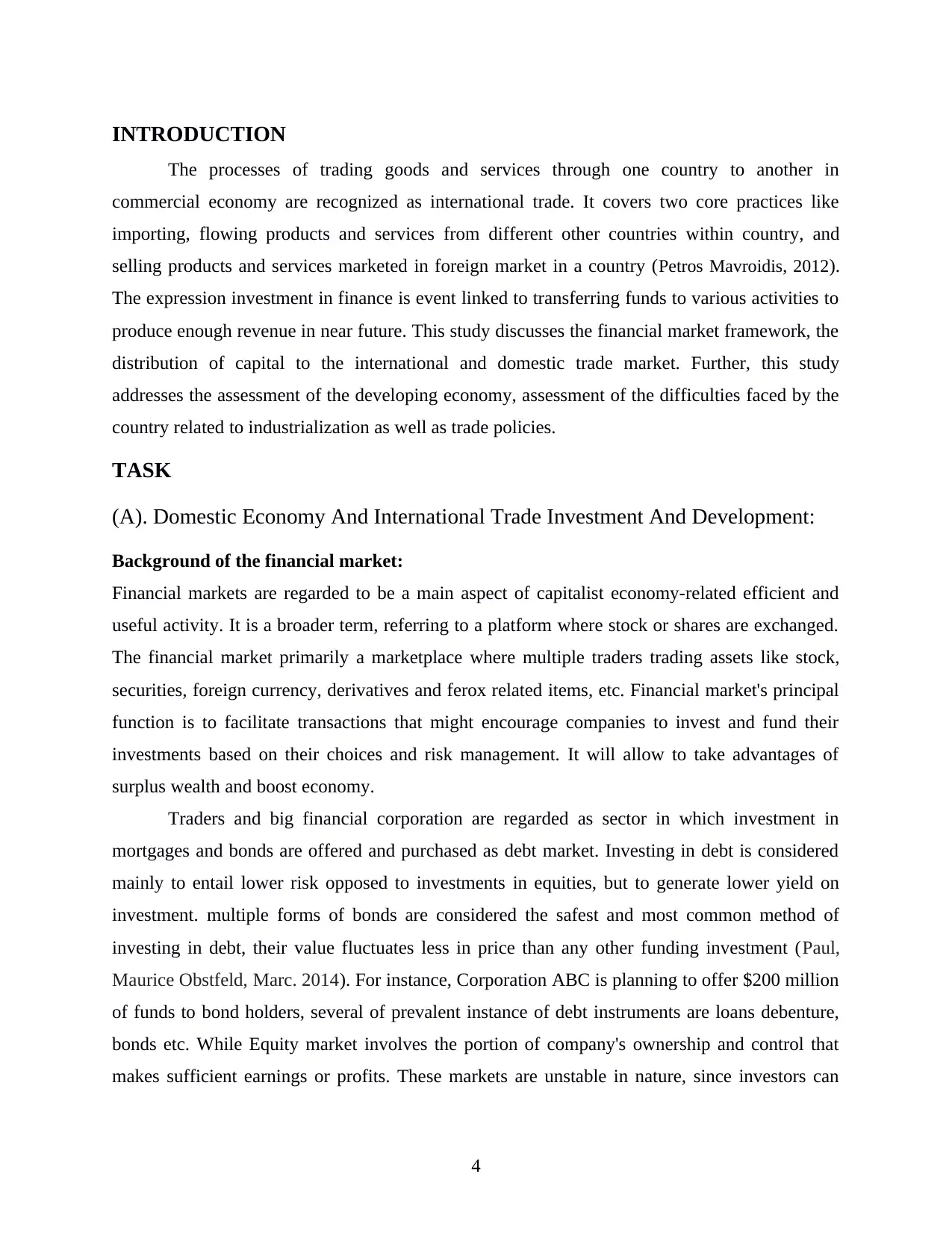
INTRODUCTION
The processes of trading goods and services through one country to another in
commercial economy are recognized as international trade. It covers two core practices like
importing, flowing products and services from different other countries within country, and
selling products and services marketed in foreign market in a country (Petros Mavroidis, 2012).
The expression investment in finance is event linked to transferring funds to various activities to
produce enough revenue in near future. This study discusses the financial market framework, the
distribution of capital to the international and domestic trade market. Further, this study
addresses the assessment of the developing economy, assessment of the difficulties faced by the
country related to industrialization as well as trade policies.
TASK
(A). Domestic Economy And International Trade Investment And Development:
Background of the financial market:
Financial markets are regarded to be a main aspect of capitalist economy-related efficient and
useful activity. It is a broader term, referring to a platform where stock or shares are exchanged.
The financial market primarily a marketplace where multiple traders trading assets like stock,
securities, foreign currency, derivatives and ferox related items, etc. Financial market's principal
function is to facilitate transactions that might encourage companies to invest and fund their
investments based on their choices and risk management. It will allow to take advantages of
surplus wealth and boost economy.
Traders and big financial corporation are regarded as sector in which investment in
mortgages and bonds are offered and purchased as debt market. Investing in debt is considered
mainly to entail lower risk opposed to investments in equities, but to generate lower yield on
investment. multiple forms of bonds are considered the safest and most common method of
investing in debt, their value fluctuates less in price than any other funding investment (Paul,
Maurice Obstfeld, Marc. 2014). For instance, Corporation ABC is planning to offer $200 million
of funds to bond holders, several of prevalent instance of debt instruments are loans debenture,
bonds etc. While Equity market involves the portion of company's ownership and control that
makes sufficient earnings or profits. These markets are unstable in nature, since investors can
4
The processes of trading goods and services through one country to another in
commercial economy are recognized as international trade. It covers two core practices like
importing, flowing products and services from different other countries within country, and
selling products and services marketed in foreign market in a country (Petros Mavroidis, 2012).
The expression investment in finance is event linked to transferring funds to various activities to
produce enough revenue in near future. This study discusses the financial market framework, the
distribution of capital to the international and domestic trade market. Further, this study
addresses the assessment of the developing economy, assessment of the difficulties faced by the
country related to industrialization as well as trade policies.
TASK
(A). Domestic Economy And International Trade Investment And Development:
Background of the financial market:
Financial markets are regarded to be a main aspect of capitalist economy-related efficient and
useful activity. It is a broader term, referring to a platform where stock or shares are exchanged.
The financial market primarily a marketplace where multiple traders trading assets like stock,
securities, foreign currency, derivatives and ferox related items, etc. Financial market's principal
function is to facilitate transactions that might encourage companies to invest and fund their
investments based on their choices and risk management. It will allow to take advantages of
surplus wealth and boost economy.
Traders and big financial corporation are regarded as sector in which investment in
mortgages and bonds are offered and purchased as debt market. Investing in debt is considered
mainly to entail lower risk opposed to investments in equities, but to generate lower yield on
investment. multiple forms of bonds are considered the safest and most common method of
investing in debt, their value fluctuates less in price than any other funding investment (Paul,
Maurice Obstfeld, Marc. 2014). For instance, Corporation ABC is planning to offer $200 million
of funds to bond holders, several of prevalent instance of debt instruments are loans debenture,
bonds etc. While Equity market involves the portion of company's ownership and control that
makes sufficient earnings or profits. These markets are unstable in nature, since investors can
4
Paraphrase This Document
Need a fresh take? Get an instant paraphrase of this document with our AI Paraphraser
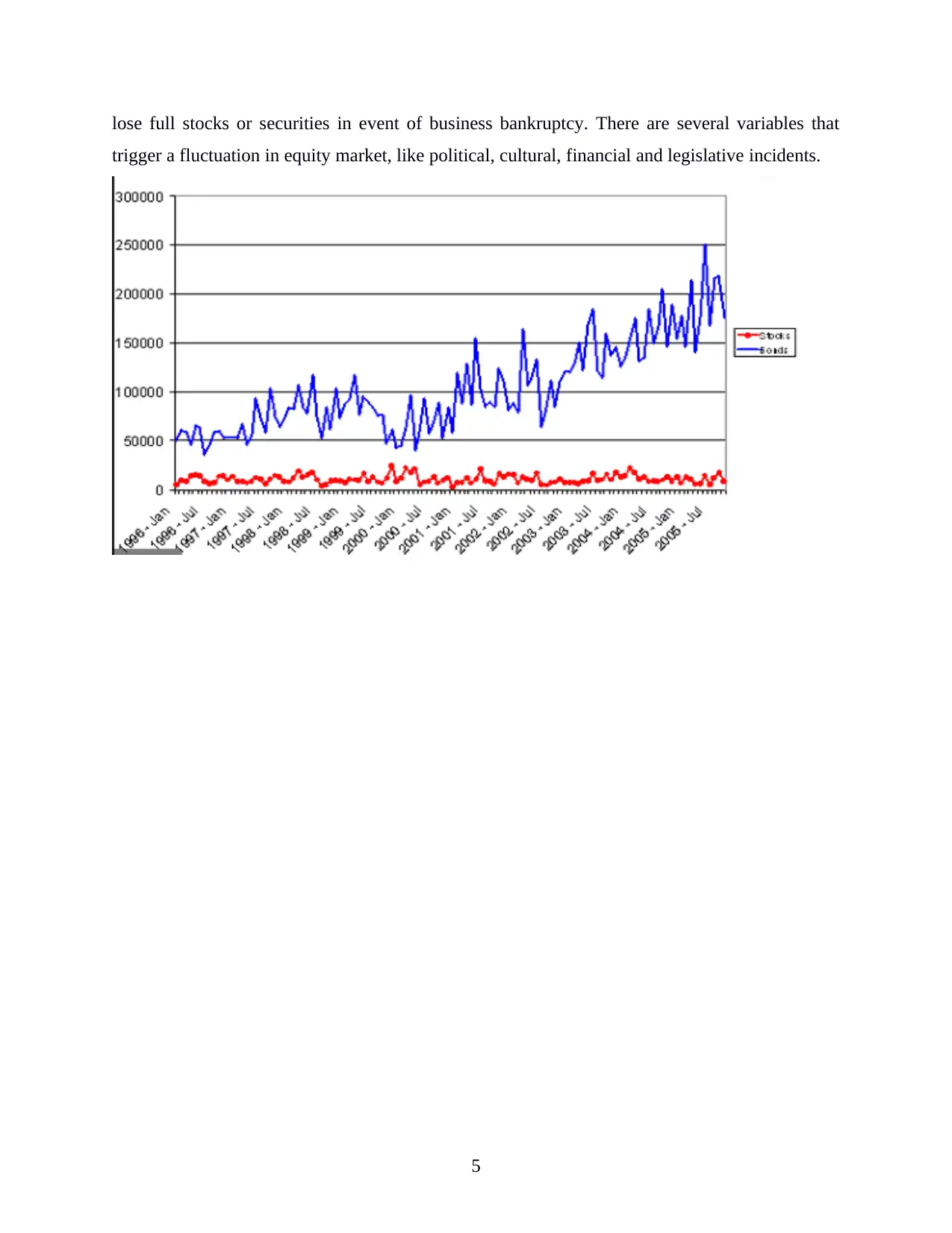
lose full stocks or securities in event of business bankruptcy. There are several variables that
trigger a fluctuation in equity market, like political, cultural, financial and legislative incidents.
5
trigger a fluctuation in equity market, like political, cultural, financial and legislative incidents.
5
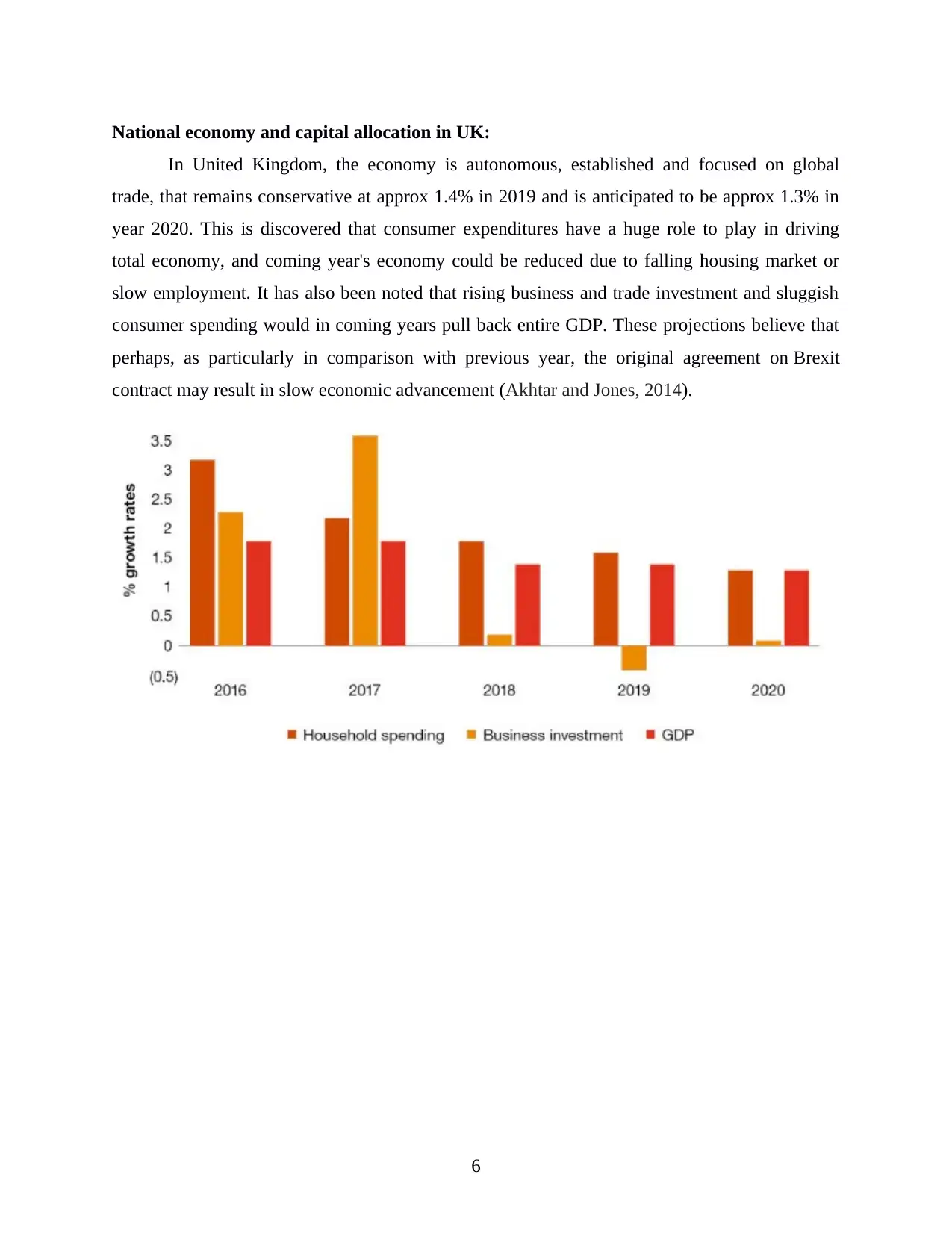
National economy and capital allocation in UK:
In United Kingdom, the economy is autonomous, established and focused on global
trade, that remains conservative at approx 1.4% in 2019 and is anticipated to be approx 1.3% in
year 2020. This is discovered that consumer expenditures have a huge role to play in driving
total economy, and coming year's economy could be reduced due to falling housing market or
slow employment. It has also been noted that rising business and trade investment and sluggish
consumer spending would in coming years pull back entire GDP. These projections believe that
perhaps, as particularly in comparison with previous year, the original agreement on Brexit
contract may result in slow economic advancement (Akhtar and Jones, 2014).
6
In United Kingdom, the economy is autonomous, established and focused on global
trade, that remains conservative at approx 1.4% in 2019 and is anticipated to be approx 1.3% in
year 2020. This is discovered that consumer expenditures have a huge role to play in driving
total economy, and coming year's economy could be reduced due to falling housing market or
slow employment. It has also been noted that rising business and trade investment and sluggish
consumer spending would in coming years pull back entire GDP. These projections believe that
perhaps, as particularly in comparison with previous year, the original agreement on Brexit
contract may result in slow economic advancement (Akhtar and Jones, 2014).
6
⊘ This is a preview!⊘
Do you want full access?
Subscribe today to unlock all pages.

Trusted by 1+ million students worldwide
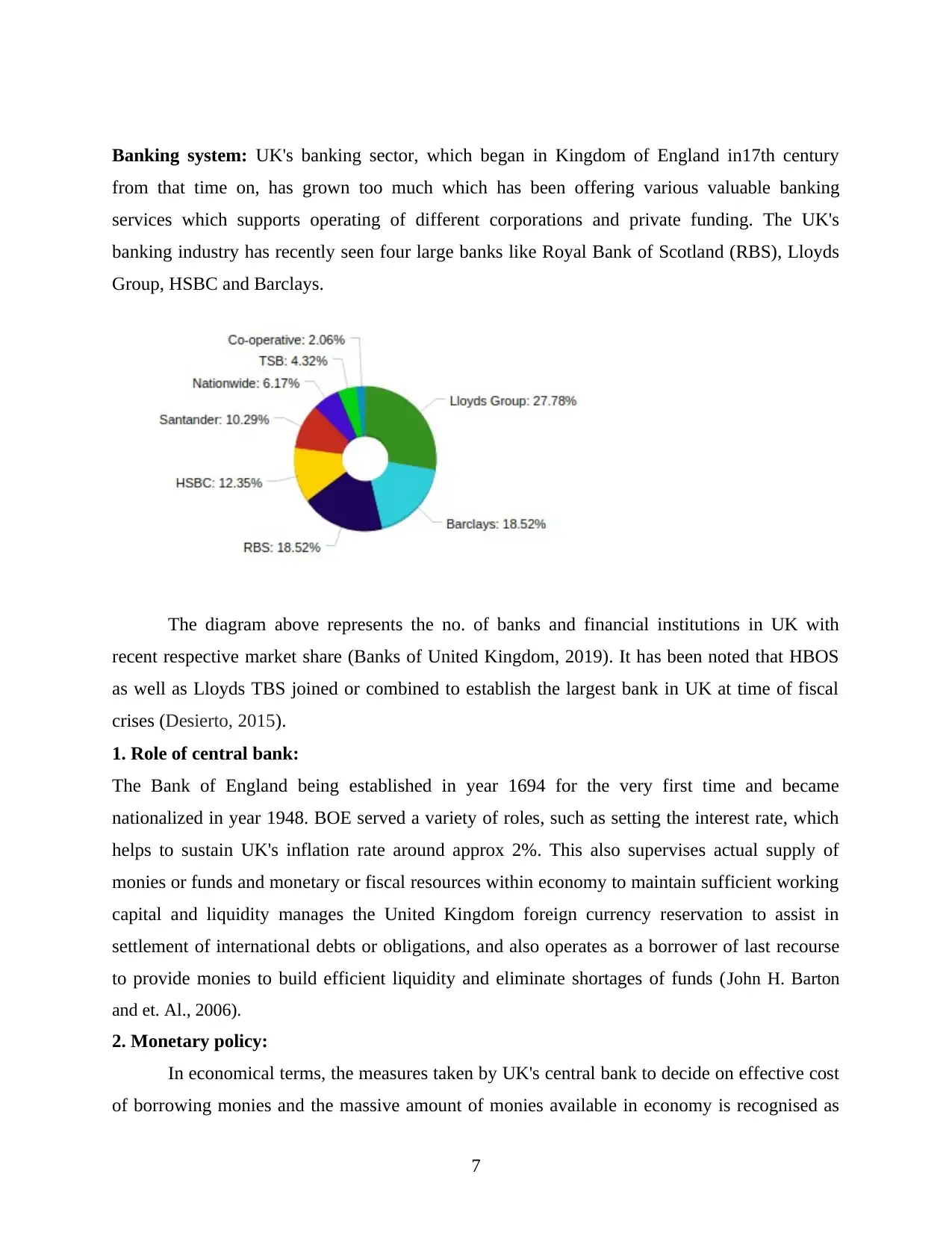
Banking system: UK's banking sector, which began in Kingdom of England in17th century
from that time on, has grown too much which has been offering various valuable banking
services which supports operating of different corporations and private funding. The UK's
banking industry has recently seen four large banks like Royal Bank of Scotland (RBS), Lloyds
Group, HSBC and Barclays.
The diagram above represents the no. of banks and financial institutions in UK with
recent respective market share (Banks of United Kingdom, 2019). It has been noted that HBOS
as well as Lloyds TBS joined or combined to establish the largest bank in UK at time of fiscal
crises (Desierto, 2015).
1. Role of central bank:
The Bank of England being established in year 1694 for the very first time and became
nationalized in year 1948. BOE served a variety of roles, such as setting the interest rate, which
helps to sustain UK's inflation rate around approx 2%. This also supervises actual supply of
monies or funds and monetary or fiscal resources within economy to maintain sufficient working
capital and liquidity manages the United Kingdom foreign currency reservation to assist in
settlement of international debts or obligations, and also operates as a borrower of last recourse
to provide monies to build efficient liquidity and eliminate shortages of funds (John H. Barton
and et. Al., 2006).
2. Monetary policy:
In economical terms, the measures taken by UK's central bank to decide on effective cost
of borrowing monies and the massive amount of monies available in economy is recognised as
7
from that time on, has grown too much which has been offering various valuable banking
services which supports operating of different corporations and private funding. The UK's
banking industry has recently seen four large banks like Royal Bank of Scotland (RBS), Lloyds
Group, HSBC and Barclays.
The diagram above represents the no. of banks and financial institutions in UK with
recent respective market share (Banks of United Kingdom, 2019). It has been noted that HBOS
as well as Lloyds TBS joined or combined to establish the largest bank in UK at time of fiscal
crises (Desierto, 2015).
1. Role of central bank:
The Bank of England being established in year 1694 for the very first time and became
nationalized in year 1948. BOE served a variety of roles, such as setting the interest rate, which
helps to sustain UK's inflation rate around approx 2%. This also supervises actual supply of
monies or funds and monetary or fiscal resources within economy to maintain sufficient working
capital and liquidity manages the United Kingdom foreign currency reservation to assist in
settlement of international debts or obligations, and also operates as a borrower of last recourse
to provide monies to build efficient liquidity and eliminate shortages of funds (John H. Barton
and et. Al., 2006).
2. Monetary policy:
In economical terms, the measures taken by UK's central bank to decide on effective cost
of borrowing monies and the massive amount of monies available in economy is recognised as
7
Paraphrase This Document
Need a fresh take? Get an instant paraphrase of this document with our AI Paraphraser
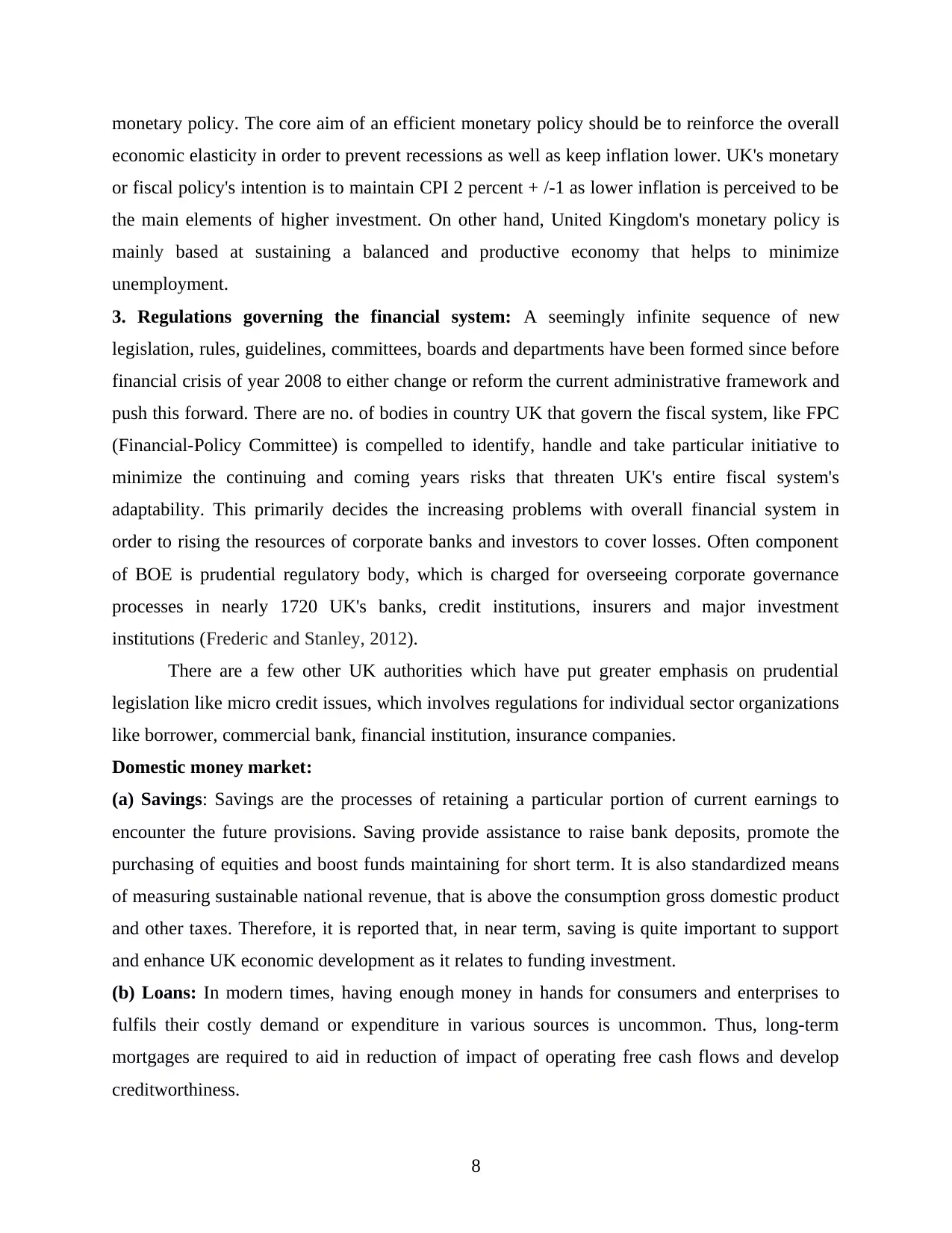
monetary policy. The core aim of an efficient monetary policy should be to reinforce the overall
economic elasticity in order to prevent recessions as well as keep inflation lower. UK's monetary
or fiscal policy's intention is to maintain CPI 2 percent + /-1 as lower inflation is perceived to be
the main elements of higher investment. On other hand, United Kingdom's monetary policy is
mainly based at sustaining a balanced and productive economy that helps to minimize
unemployment.
3. Regulations governing the financial system: A seemingly infinite sequence of new
legislation, rules, guidelines, committees, boards and departments have been formed since before
financial crisis of year 2008 to either change or reform the current administrative framework and
push this forward. There are no. of bodies in country UK that govern the fiscal system, like FPC
(Financial-Policy Committee) is compelled to identify, handle and take particular initiative to
minimize the continuing and coming years risks that threaten UK's entire fiscal system's
adaptability. This primarily decides the increasing problems with overall financial system in
order to rising the resources of corporate banks and investors to cover losses. Often component
of BOE is prudential regulatory body, which is charged for overseeing corporate governance
processes in nearly 1720 UK's banks, credit institutions, insurers and major investment
institutions (Frederic and Stanley, 2012).
There are a few other UK authorities which have put greater emphasis on prudential
legislation like micro credit issues, which involves regulations for individual sector organizations
like borrower, commercial bank, financial institution, insurance companies.
Domestic money market:
(a) Savings: Savings are the processes of retaining a particular portion of current earnings to
encounter the future provisions. Saving provide assistance to raise bank deposits, promote the
purchasing of equities and boost funds maintaining for short term. It is also standardized means
of measuring sustainable national revenue, that is above the consumption gross domestic product
and other taxes. Therefore, it is reported that, in near term, saving is quite important to support
and enhance UK economic development as it relates to funding investment.
(b) Loans: In modern times, having enough money in hands for consumers and enterprises to
fulfils their costly demand or expenditure in various sources is uncommon. Thus, long-term
mortgages are required to aid in reduction of impact of operating free cash flows and develop
creditworthiness.
8
economic elasticity in order to prevent recessions as well as keep inflation lower. UK's monetary
or fiscal policy's intention is to maintain CPI 2 percent + /-1 as lower inflation is perceived to be
the main elements of higher investment. On other hand, United Kingdom's monetary policy is
mainly based at sustaining a balanced and productive economy that helps to minimize
unemployment.
3. Regulations governing the financial system: A seemingly infinite sequence of new
legislation, rules, guidelines, committees, boards and departments have been formed since before
financial crisis of year 2008 to either change or reform the current administrative framework and
push this forward. There are no. of bodies in country UK that govern the fiscal system, like FPC
(Financial-Policy Committee) is compelled to identify, handle and take particular initiative to
minimize the continuing and coming years risks that threaten UK's entire fiscal system's
adaptability. This primarily decides the increasing problems with overall financial system in
order to rising the resources of corporate banks and investors to cover losses. Often component
of BOE is prudential regulatory body, which is charged for overseeing corporate governance
processes in nearly 1720 UK's banks, credit institutions, insurers and major investment
institutions (Frederic and Stanley, 2012).
There are a few other UK authorities which have put greater emphasis on prudential
legislation like micro credit issues, which involves regulations for individual sector organizations
like borrower, commercial bank, financial institution, insurance companies.
Domestic money market:
(a) Savings: Savings are the processes of retaining a particular portion of current earnings to
encounter the future provisions. Saving provide assistance to raise bank deposits, promote the
purchasing of equities and boost funds maintaining for short term. It is also standardized means
of measuring sustainable national revenue, that is above the consumption gross domestic product
and other taxes. Therefore, it is reported that, in near term, saving is quite important to support
and enhance UK economic development as it relates to funding investment.
(b) Loans: In modern times, having enough money in hands for consumers and enterprises to
fulfils their costly demand or expenditure in various sources is uncommon. Thus, long-term
mortgages are required to aid in reduction of impact of operating free cash flows and develop
creditworthiness.
8
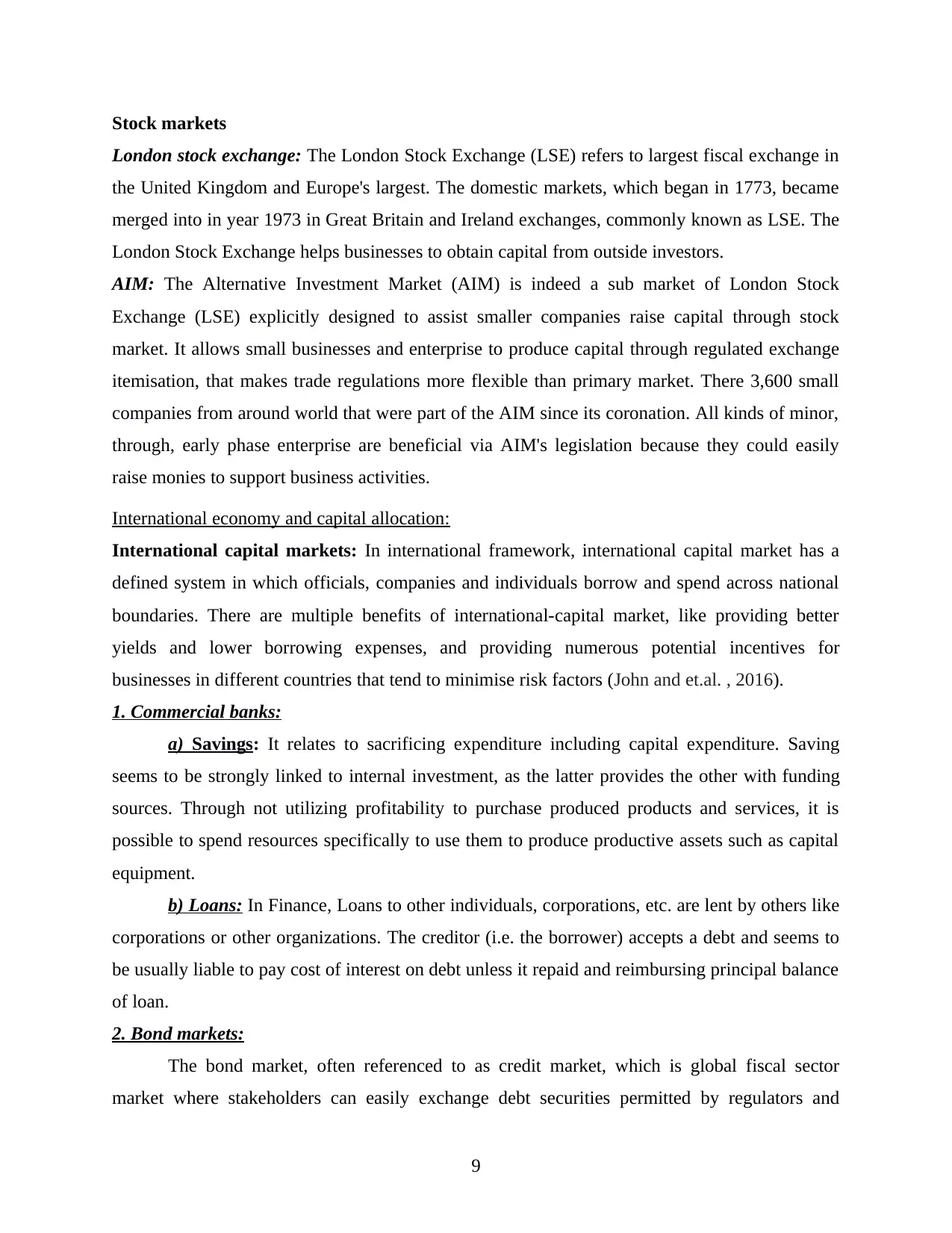
Stock markets
London stock exchange: The London Stock Exchange (LSE) refers to largest fiscal exchange in
the United Kingdom and Europe's largest. The domestic markets, which began in 1773, became
merged into in year 1973 in Great Britain and Ireland exchanges, commonly known as LSE. The
London Stock Exchange helps businesses to obtain capital from outside investors.
AIM: The Alternative Investment Market (AIM) is indeed a sub market of London Stock
Exchange (LSE) explicitly designed to assist smaller companies raise capital through stock
market. It allows small businesses and enterprise to produce capital through regulated exchange
itemisation, that makes trade regulations more flexible than primary market. There 3,600 small
companies from around world that were part of the AIM since its coronation. All kinds of minor,
through, early phase enterprise are beneficial via AIM's legislation because they could easily
raise monies to support business activities.
International economy and capital allocation:
International capital markets: In international framework, international capital market has a
defined system in which officials, companies and individuals borrow and spend across national
boundaries. There are multiple benefits of international-capital market, like providing better
yields and lower borrowing expenses, and providing numerous potential incentives for
businesses in different countries that tend to minimise risk factors (John and et.al. , 2016).
1. Commercial banks:
a) Savings: It relates to sacrificing expenditure including capital expenditure. Saving
seems to be strongly linked to internal investment, as the latter provides the other with funding
sources. Through not utilizing profitability to purchase produced products and services, it is
possible to spend resources specifically to use them to produce productive assets such as capital
equipment.
b) Loans: In Finance, Loans to other individuals, corporations, etc. are lent by others like
corporations or other organizations. The creditor (i.e. the borrower) accepts a debt and seems to
be usually liable to pay cost of interest on debt unless it repaid and reimbursing principal balance
of loan.
2. Bond markets:
The bond market, often referenced to as credit market, which is global fiscal sector
market where stakeholders can easily exchange debt securities permitted by regulators and
9
London stock exchange: The London Stock Exchange (LSE) refers to largest fiscal exchange in
the United Kingdom and Europe's largest. The domestic markets, which began in 1773, became
merged into in year 1973 in Great Britain and Ireland exchanges, commonly known as LSE. The
London Stock Exchange helps businesses to obtain capital from outside investors.
AIM: The Alternative Investment Market (AIM) is indeed a sub market of London Stock
Exchange (LSE) explicitly designed to assist smaller companies raise capital through stock
market. It allows small businesses and enterprise to produce capital through regulated exchange
itemisation, that makes trade regulations more flexible than primary market. There 3,600 small
companies from around world that were part of the AIM since its coronation. All kinds of minor,
through, early phase enterprise are beneficial via AIM's legislation because they could easily
raise monies to support business activities.
International economy and capital allocation:
International capital markets: In international framework, international capital market has a
defined system in which officials, companies and individuals borrow and spend across national
boundaries. There are multiple benefits of international-capital market, like providing better
yields and lower borrowing expenses, and providing numerous potential incentives for
businesses in different countries that tend to minimise risk factors (John and et.al. , 2016).
1. Commercial banks:
a) Savings: It relates to sacrificing expenditure including capital expenditure. Saving
seems to be strongly linked to internal investment, as the latter provides the other with funding
sources. Through not utilizing profitability to purchase produced products and services, it is
possible to spend resources specifically to use them to produce productive assets such as capital
equipment.
b) Loans: In Finance, Loans to other individuals, corporations, etc. are lent by others like
corporations or other organizations. The creditor (i.e. the borrower) accepts a debt and seems to
be usually liable to pay cost of interest on debt unless it repaid and reimbursing principal balance
of loan.
2. Bond markets:
The bond market, often referenced to as credit market, which is global fiscal sector
market where stakeholders can easily exchange debt securities permitted by regulators and
9
⊘ This is a preview!⊘
Do you want full access?
Subscribe today to unlock all pages.

Trusted by 1+ million students worldwide
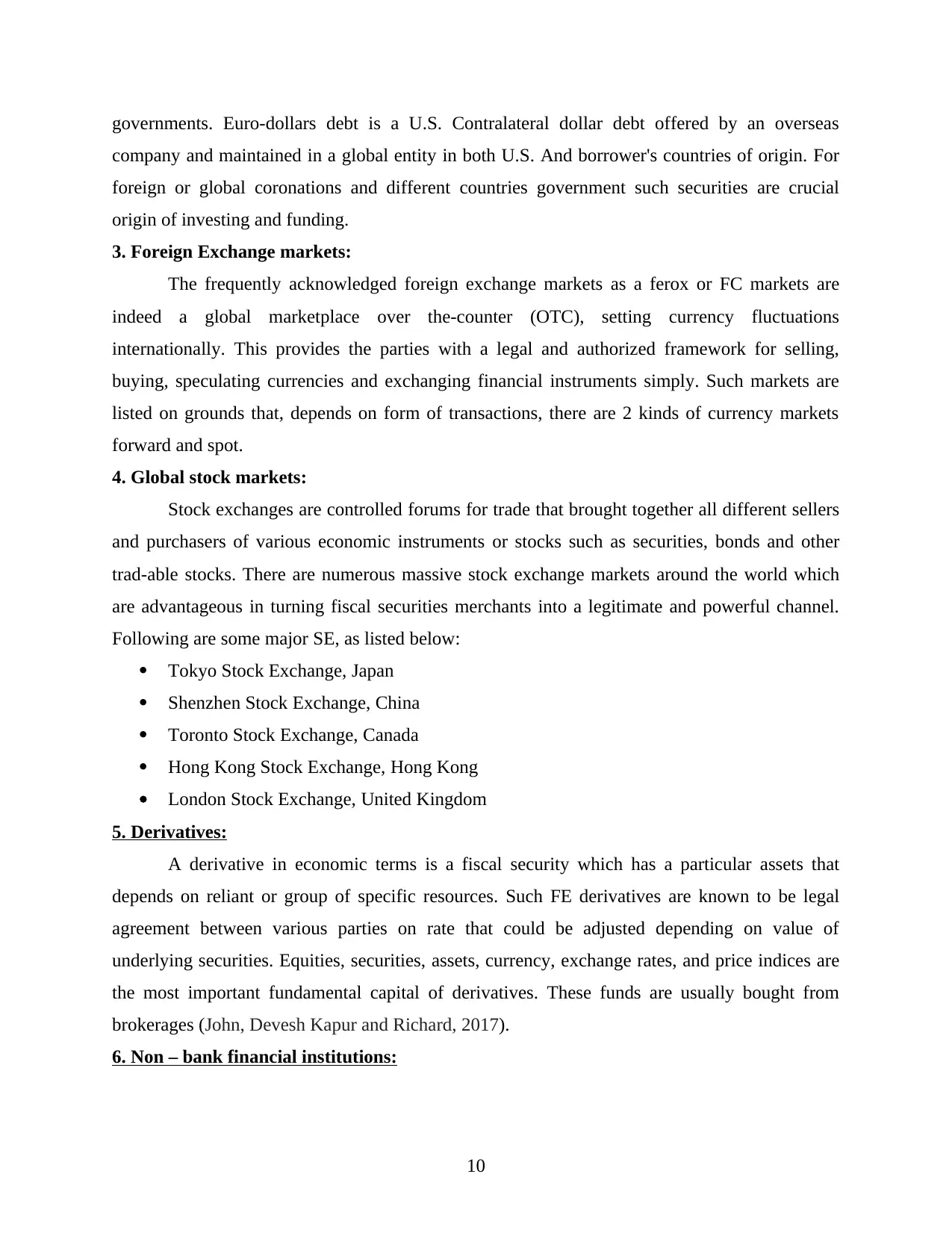
governments. Euro-dollars debt is a U.S. Contralateral dollar debt offered by an overseas
company and maintained in a global entity in both U.S. And borrower's countries of origin. For
foreign or global coronations and different countries government such securities are crucial
origin of investing and funding.
3. Foreign Exchange markets:
The frequently acknowledged foreign exchange markets as a ferox or FC markets are
indeed a global marketplace over the-counter (OTC), setting currency fluctuations
internationally. This provides the parties with a legal and authorized framework for selling,
buying, speculating currencies and exchanging financial instruments simply. Such markets are
listed on grounds that, depends on form of transactions, there are 2 kinds of currency markets
forward and spot.
4. Global stock markets:
Stock exchanges are controlled forums for trade that brought together all different sellers
and purchasers of various economic instruments or stocks such as securities, bonds and other
trad-able stocks. There are numerous massive stock exchange markets around the world which
are advantageous in turning fiscal securities merchants into a legitimate and powerful channel.
Following are some major SE, as listed below:
Tokyo Stock Exchange, Japan
Shenzhen Stock Exchange, China
Toronto Stock Exchange, Canada
Hong Kong Stock Exchange, Hong Kong
London Stock Exchange, United Kingdom
5. Derivatives:
A derivative in economic terms is a fiscal security which has a particular assets that
depends on reliant or group of specific resources. Such FE derivatives are known to be legal
agreement between various parties on rate that could be adjusted depending on value of
underlying securities. Equities, securities, assets, currency, exchange rates, and price indices are
the most important fundamental capital of derivatives. These funds are usually bought from
brokerages (John, Devesh Kapur and Richard, 2017).
6. Non – bank financial institutions:
10
company and maintained in a global entity in both U.S. And borrower's countries of origin. For
foreign or global coronations and different countries government such securities are crucial
origin of investing and funding.
3. Foreign Exchange markets:
The frequently acknowledged foreign exchange markets as a ferox or FC markets are
indeed a global marketplace over the-counter (OTC), setting currency fluctuations
internationally. This provides the parties with a legal and authorized framework for selling,
buying, speculating currencies and exchanging financial instruments simply. Such markets are
listed on grounds that, depends on form of transactions, there are 2 kinds of currency markets
forward and spot.
4. Global stock markets:
Stock exchanges are controlled forums for trade that brought together all different sellers
and purchasers of various economic instruments or stocks such as securities, bonds and other
trad-able stocks. There are numerous massive stock exchange markets around the world which
are advantageous in turning fiscal securities merchants into a legitimate and powerful channel.
Following are some major SE, as listed below:
Tokyo Stock Exchange, Japan
Shenzhen Stock Exchange, China
Toronto Stock Exchange, Canada
Hong Kong Stock Exchange, Hong Kong
London Stock Exchange, United Kingdom
5. Derivatives:
A derivative in economic terms is a fiscal security which has a particular assets that
depends on reliant or group of specific resources. Such FE derivatives are known to be legal
agreement between various parties on rate that could be adjusted depending on value of
underlying securities. Equities, securities, assets, currency, exchange rates, and price indices are
the most important fundamental capital of derivatives. These funds are usually bought from
brokerages (John, Devesh Kapur and Richard, 2017).
6. Non – bank financial institutions:
10
Paraphrase This Document
Need a fresh take? Get an instant paraphrase of this document with our AI Paraphraser
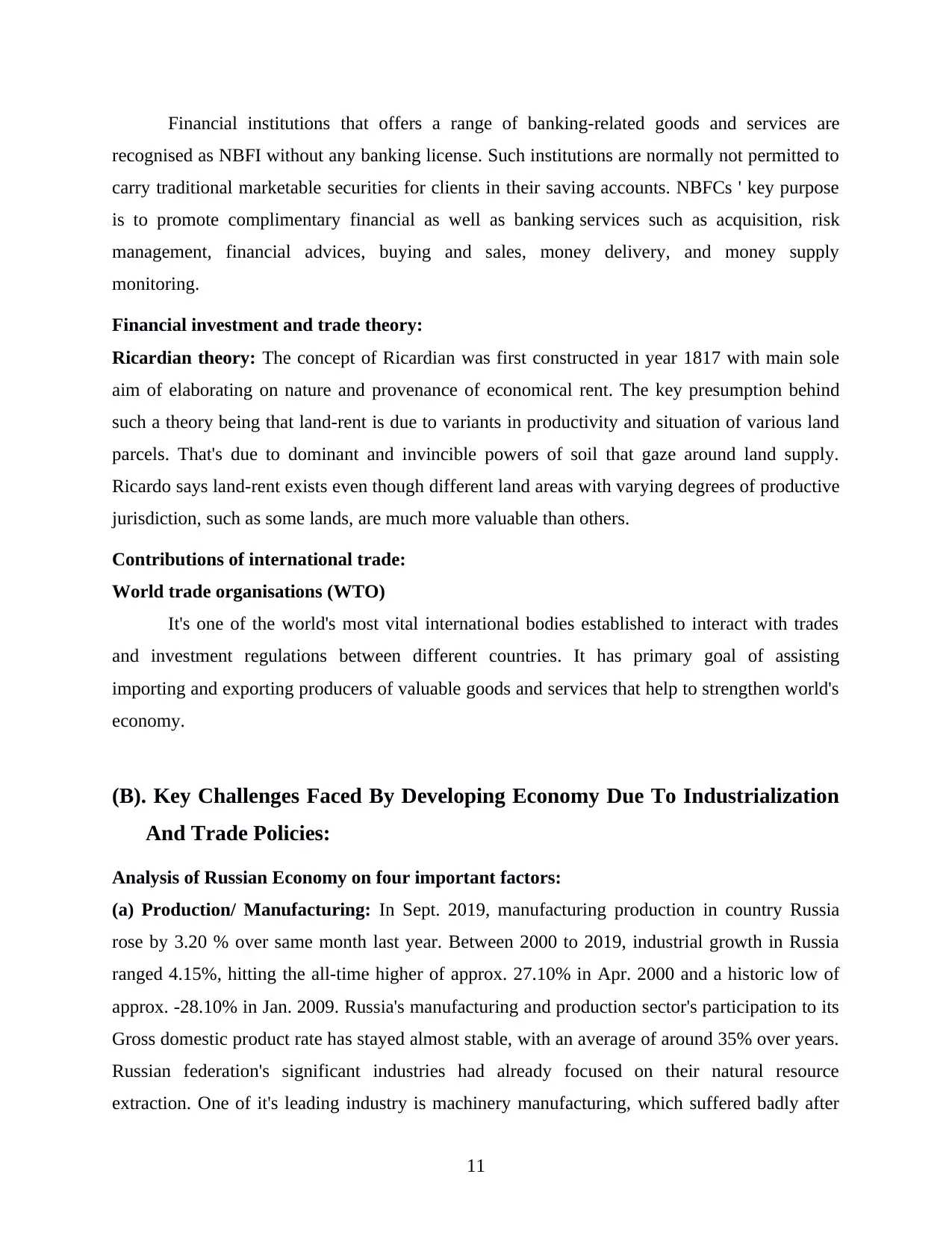
Financial institutions that offers a range of banking-related goods and services are
recognised as NBFI without any banking license. Such institutions are normally not permitted to
carry traditional marketable securities for clients in their saving accounts. NBFCs ' key purpose
is to promote complimentary financial as well as banking services such as acquisition, risk
management, financial advices, buying and sales, money delivery, and money supply
monitoring.
Financial investment and trade theory:
Ricardian theory: The concept of Ricardian was first constructed in year 1817 with main sole
aim of elaborating on nature and provenance of economical rent. The key presumption behind
such a theory being that land-rent is due to variants in productivity and situation of various land
parcels. That's due to dominant and invincible powers of soil that gaze around land supply.
Ricardo says land-rent exists even though different land areas with varying degrees of productive
jurisdiction, such as some lands, are much more valuable than others.
Contributions of international trade:
World trade organisations (WTO)
It's one of the world's most vital international bodies established to interact with trades
and investment regulations between different countries. It has primary goal of assisting
importing and exporting producers of valuable goods and services that help to strengthen world's
economy.
(B). Key Challenges Faced By Developing Economy Due To Industrialization
And Trade Policies:
Analysis of Russian Economy on four important factors:
(a) Production/ Manufacturing: In Sept. 2019, manufacturing production in country Russia
rose by 3.20 % over same month last year. Between 2000 to 2019, industrial growth in Russia
ranged 4.15%, hitting the all-time higher of approx. 27.10% in Apr. 2000 and a historic low of
approx. -28.10% in Jan. 2009. Russia's manufacturing and production sector's participation to its
Gross domestic product rate has stayed almost stable, with an average of around 35% over years.
Russian federation's significant industries had already focused on their natural resource
extraction. One of it's leading industry is machinery manufacturing, which suffered badly after
11
recognised as NBFI without any banking license. Such institutions are normally not permitted to
carry traditional marketable securities for clients in their saving accounts. NBFCs ' key purpose
is to promote complimentary financial as well as banking services such as acquisition, risk
management, financial advices, buying and sales, money delivery, and money supply
monitoring.
Financial investment and trade theory:
Ricardian theory: The concept of Ricardian was first constructed in year 1817 with main sole
aim of elaborating on nature and provenance of economical rent. The key presumption behind
such a theory being that land-rent is due to variants in productivity and situation of various land
parcels. That's due to dominant and invincible powers of soil that gaze around land supply.
Ricardo says land-rent exists even though different land areas with varying degrees of productive
jurisdiction, such as some lands, are much more valuable than others.
Contributions of international trade:
World trade organisations (WTO)
It's one of the world's most vital international bodies established to interact with trades
and investment regulations between different countries. It has primary goal of assisting
importing and exporting producers of valuable goods and services that help to strengthen world's
economy.
(B). Key Challenges Faced By Developing Economy Due To Industrialization
And Trade Policies:
Analysis of Russian Economy on four important factors:
(a) Production/ Manufacturing: In Sept. 2019, manufacturing production in country Russia
rose by 3.20 % over same month last year. Between 2000 to 2019, industrial growth in Russia
ranged 4.15%, hitting the all-time higher of approx. 27.10% in Apr. 2000 and a historic low of
approx. -28.10% in Jan. 2009. Russia's manufacturing and production sector's participation to its
Gross domestic product rate has stayed almost stable, with an average of around 35% over years.
Russian federation's significant industries had already focused on their natural resource
extraction. One of it's leading industry is machinery manufacturing, which suffered badly after
11
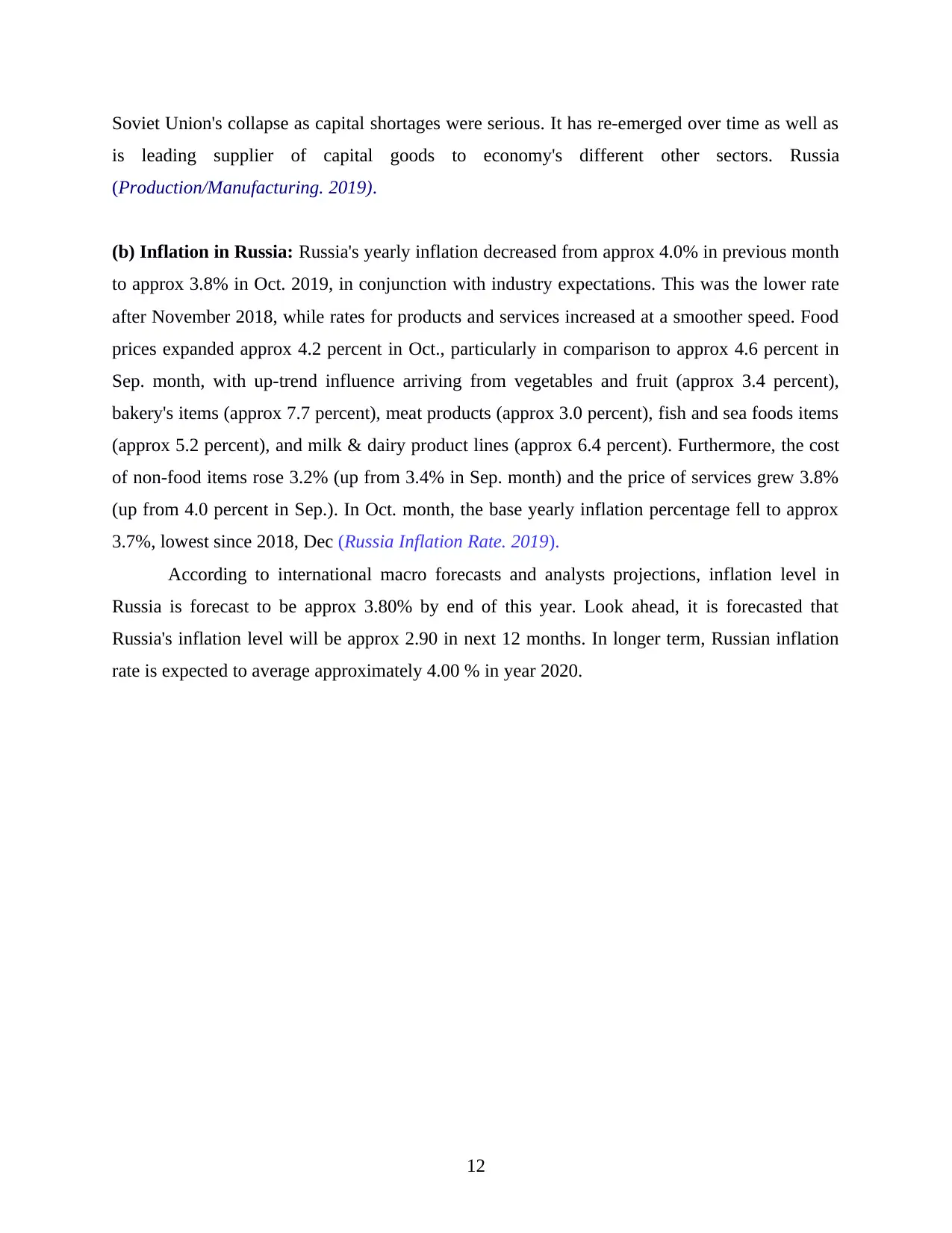
Soviet Union's collapse as capital shortages were serious. It has re-emerged over time as well as
is leading supplier of capital goods to economy's different other sectors. Russia
(Production/Manufacturing. 2019).
(b) Inflation in Russia: Russia's yearly inflation decreased from approx 4.0% in previous month
to approx 3.8% in Oct. 2019, in conjunction with industry expectations. This was the lower rate
after November 2018, while rates for products and services increased at a smoother speed. Food
prices expanded approx 4.2 percent in Oct., particularly in comparison to approx 4.6 percent in
Sep. month, with up-trend influence arriving from vegetables and fruit (approx 3.4 percent),
bakery's items (approx 7.7 percent), meat products (approx 3.0 percent), fish and sea foods items
(approx 5.2 percent), and milk & dairy product lines (approx 6.4 percent). Furthermore, the cost
of non-food items rose 3.2% (up from 3.4% in Sep. month) and the price of services grew 3.8%
(up from 4.0 percent in Sep.). In Oct. month, the base yearly inflation percentage fell to approx
3.7%, lowest since 2018, Dec (Russia Inflation Rate. 2019).
According to international macro forecasts and analysts projections, inflation level in
Russia is forecast to be approx 3.80% by end of this year. Look ahead, it is forecasted that
Russia's inflation level will be approx 2.90 in next 12 months. In longer term, Russian inflation
rate is expected to average approximately 4.00 % in year 2020.
12
is leading supplier of capital goods to economy's different other sectors. Russia
(Production/Manufacturing. 2019).
(b) Inflation in Russia: Russia's yearly inflation decreased from approx 4.0% in previous month
to approx 3.8% in Oct. 2019, in conjunction with industry expectations. This was the lower rate
after November 2018, while rates for products and services increased at a smoother speed. Food
prices expanded approx 4.2 percent in Oct., particularly in comparison to approx 4.6 percent in
Sep. month, with up-trend influence arriving from vegetables and fruit (approx 3.4 percent),
bakery's items (approx 7.7 percent), meat products (approx 3.0 percent), fish and sea foods items
(approx 5.2 percent), and milk & dairy product lines (approx 6.4 percent). Furthermore, the cost
of non-food items rose 3.2% (up from 3.4% in Sep. month) and the price of services grew 3.8%
(up from 4.0 percent in Sep.). In Oct. month, the base yearly inflation percentage fell to approx
3.7%, lowest since 2018, Dec (Russia Inflation Rate. 2019).
According to international macro forecasts and analysts projections, inflation level in
Russia is forecast to be approx 3.80% by end of this year. Look ahead, it is forecasted that
Russia's inflation level will be approx 2.90 in next 12 months. In longer term, Russian inflation
rate is expected to average approximately 4.00 % in year 2020.
12
⊘ This is a preview!⊘
Do you want full access?
Subscribe today to unlock all pages.

Trusted by 1+ million students worldwide
1 out of 19
Related Documents
Your All-in-One AI-Powered Toolkit for Academic Success.
+13062052269
info@desklib.com
Available 24*7 on WhatsApp / Email
![[object Object]](/_next/static/media/star-bottom.7253800d.svg)
Unlock your academic potential
Copyright © 2020–2025 A2Z Services. All Rights Reserved. Developed and managed by ZUCOL.




